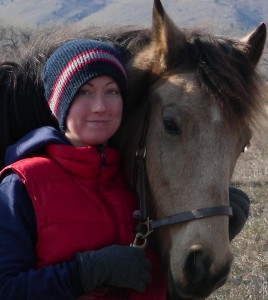By Heather Davis
I am a certified equine “massage” therapist, applying principles of touch to encourage horses to release old neuromuscular strain patterns and relearn how to exist without previously held pain and resistance. Much of my work is informed by the work of Ida Rolf (known as “Rolfing” or Structural Integration), osteopathy, shiatsu, and myofascial release. Many horses, when asked to “let go” of old tension and memory stored within the body’s vastly intelligent network of innervated structural soft tissue, will take some time to relax into the willingness to release. I am asking horses to tune into parts of their body that may be uncomfortable. These are areas where, often, the horse has spent a great deal of time and energy avoiding. So, it is not surprising to see horses feeling fidgety or anxious about my request for their attention to be brought back into these areas.
Usually, when confronted with this “fidgety” response from a horse, I take it as a message to readjust my approach. It can take a bit of time initially to figure out how to get the horse willing to be with me and make releases. When I began working with Danke, Sharon’s tall and lovely chestnut warmblood mare, we had a little difficulty getting her to settle in and relax into the release process. Even the simple presence of my hand on or near some of her troubled areas would find Danke tossing her head, pinning her ears, and moving her body to avoid the touch. Since my work’s goal is to inspire release, it certainly wasn’t helpful to be battling Danke into demanding that she stand still and be
present with us. Sometimes those demands would lead to more resistance in her body and it would be the two-step-forward, three-step-back approach.
Sharon asked me how I felt about us clicking Danke for the behavior (namely the relaxed and willing behavior) we were looking for. Would it be distracting? I thought it would. I felt like shifting Danke’s attention “outward” onto the click and reward process with Sharon might take Danke’s attention away from me and my hands and from going “internal” with her attention. But, we decided to give it a shot.
I stood on a hay bale (Danke is a tall drink of water!) over Danke’s right hip area. Sharon stood at Danke’s head and we broke the whole process down into little pieces. First piece: asking Danke to stand next to the hay bale without moving while we briefly place a hand on the area of trouble. When Danke is still for even a moment in this, Sharon clicks and offers a reward. (This step actually consisted of a set of sub-steps.) Second piece: lengthen the time Danke is standing still next to the hay bale and remaining still (and relaxed) for a hand on her hip. Third piece: I wait for the “feeling” in my hands that Danke has shifted her attention to her hip and sacrum area. As soon as I feel this, I click, and Sharon is waiting at Danke’s head to offer the reward. Little by little, we are shaping Danke’s attention by rewarding her when she makes the decision to soften into my touch. It is working! And Sharon and I are so excited about what we have found! Teamwork! Danke is willingly deciding to bring her awareness into her troubled areas and offer release.
As it turns out, the use of “clicker training” was NOT distracting for Danke’s task of focusing inward. Not only was it not distracting, it was actually helpful! It allowed us to prevent instilling yet more resistance in her mind and body with continued requests for her to be still. Once she understood what we were asking (soften into my touch), the physical release process actually seemed much easier for her. The mental brace against the release of her hip was much more of a hurdle than the actual release of the hip itself. That is, once we opened the door with clicker training for Danke to let go of the mental guarding of her hip, the actual hands-on release work for that same area came relatively easily.
What a discovery!! I look forward to continuing this exciting work with Danke.
[Sharon’s Note: Heather Davis is an Equine Massage Therapist. You can reach her via email at hdavis1234 @ yahoo.com.]



How exciting! I enjoyed reading about these discoveries.
Sounds like a great experience for you, Heather and the mare.
Mary
Awesome! Have you been able to fade the c/t yet?
This all happened just the other day. So, we haven’t had a chance to see how she would feel about the work sans c/t support yet. We’ll have to see how it goes in follow up visits. Thanks for your comment!
Very exciting. You’re clicking your way past the horse’s survival, bracing response. I think once you’re past that, the horse will accept the work much more readily. I get the feeling that the horse’s nervous system can be conditioned to let go and release tension.
Hi Jim,
Thanks for commenting! I thought you might find the whole experience an interesting one. 🙂 We’ll post updates as we go.
Oh yeah… Happy New Year!